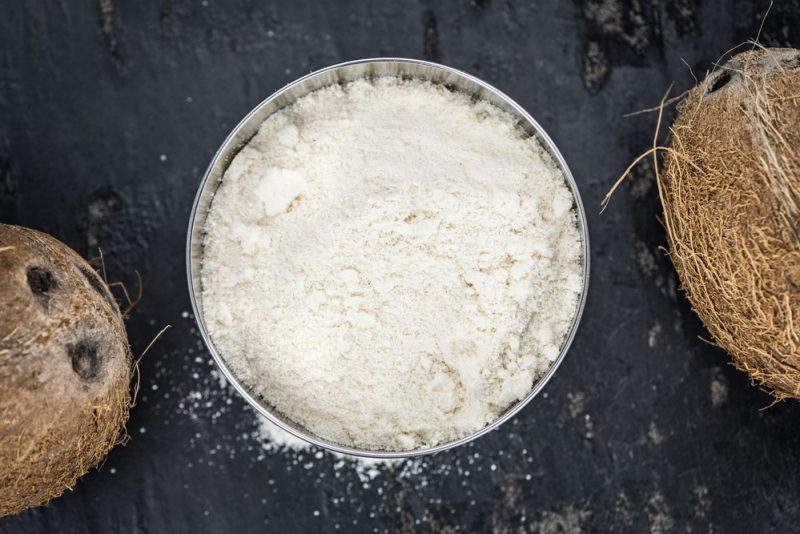Coconut Flour is no doubt one of the most flavorful starches you can ever use for baked goods. The aroma is undeniably oozing with such a desirable scent that you won’t need much of vanilla extract. It’s also packed with health benefits that your body will totally approve especially when maintaining a healthy lifestyle.
It’s an unfortunate situation if you found out that your coconut flour has already run out and you need to bake ASAP. But instead of running into your nearest grocery store, hold up and replace it with wheat flour instead. You can also use almond flour, rice flour, and flax meal.
Coconut Flour Substitutes
Get your kitchen notebook and list down all these substitutes and how you can turn them into one of a kind dishes.
1. Wheat Flour
Wheat flour is such a diverse super grain that has proven its worth for years. From bread to pastries and savory dishes, is there anything that this flour can’t do? I bet none. That’s why I personally stock it in my pantry to bake fresh goodies all year round.
The advantage of using wheat flour is that it has almost the same health benefits as coconut flour. It’s low carb, gluten-free, and rich in fiber. It improves your digestive tract, keeping out those harmful bacteria that stay in our intestines. Also, it’s always readily available in most grocery stores making it perfect as a go-to flour or most bakers.
Although it doesn’t have the same aroma and sweetness from coconut flour, it still serves its purpose.
2. Almond Flour
Almond Flour is also a great substitute for coconut flour. It won’t have that much difference when it comes to the aroma and taste. Almond flour has a naturally nutty taste that can compete with coconut’s sweet nutty taste as well.
It also has its own aroma, although not as much as aromatic as coconut, it exudes a little hint of sweetness to the dish.
Almonds are very rich in protein compared to coconut. A handful of almonds a day can already help you make up your daily protein needs. How much more when you use it as a carb meal, that would be great! That’s why it made it on our list as one of the best substitutes for coconut flour. It’s equally healthy and useful and effective in most baked goods.
A cup of almond flour is enough to cover for a cup of coconut flour. It’s simple, just follow the 1:1 ratio. Since both have the same characteristics as starch, it’s safe to say that you won’t need that much adjustment to make for your dish.
Here’s an afternoon snack you can make at home with almond flour.
3. Rice Flour
Rice has been known throughout the years as a perfect pairing with savory dishes. Around Asia, it’s popular as a staple food or side dish throughout the day from breakfast to dinner. It’s also commonly used for making desserts from sticky rice and mochi. Most Asian desserts use rice flour to easily create delectable desserts in a matter of time.
Rice flour can be a perfect substitute for coconut flour because of its ability to make sticky and gooey desserts. It’s not as aromatic and tasty as coconut flour, but it offers a more chewy and sticky texture to your sweet treats.
Rice flour is a good source of carbs and is an excellent absorbent of flavor and moisture. To replace a cup of coconut flour, just use ¾ cup of rice flour for substitution. Keep in mind that rice flour is highly absorbent compared to coconut flour so you won’t need that much for your dish. I recommend using Thai Rice Flour.
4. Flax Meal
Flax seeds are common nowadays when it comes to maintaining a healthy lifestyle. You can use it for making vegan or plant-based recipes that don’t use regular flour. It’s the perfect alternative for splurging yourself with baked goodies without risking your healthy lifestyle.
Flax meal or powder comes from its seeds, that was dried then powdered for certain purposes. It’s rich in healthy fats, fiber, and antioxidants that your body needs to function at its best. No wonder why flax has made it to the list of superfoods that you should start stocking in your pantry.
It is not affordable as coconut flour but it works well as a substitute. It wouldn’t hurt spending a few bucks for quality, right? It’s also not hard to substitute it since it also uses a 1:1 ratio for most baked goods.
If you’re craving for a cake but it’s not your cheat day yet, here’s a healthier recipe that you can try to make your cake happen.
Conversion Guide
| COCONUT FLOUR SUBSTITUTES | Versus 1 CUP |
| Wheat Flour | ¾ cup |
| Almond Flour | 1 cup |
| Rice Flour | ¾ cup |
| Flax Meal | 1 cup |
Related Questions
If I don’t have all those four above, can I substitute Coconut Flour with All-Purpose Flour?
Sure you can! But take note that you can’t follow the 1:1 ratio like most of the flours mentioned above. For a cup of coconut flour, you will need to substitute ¾ cup of all-purpose flour. Also, adjust when adding in liquids since some all-purpose flour can be highly absorbent.
Keep in mind as well that eggs must be adjusted, too aside from the liquids. It will depend on what kind of baked dish or goods you’re making. With experience and experimentation, you’ll learn more which works best for specific pastries or bread.
If you run out Coconut Flour, can you make it from scratch at home?
If you have the luxury of time, sure can. There are lots of recipes and methods you can find online that teaches you how to make from scratch.
All you have to get are fresh coconut pulps, bake them until it’s dried. Then let it rest to cool down. Take them into the food processor and grind it until it’s powdered in form. Easy peasy!
Is Coconut Flour and Coconut Powder the same?
I know it’s confusing to see different items that are almost the same. You never know which ones you’re gonna get.
Take note that coconut flour is a type of coconut powder. Coconut powder can be for food uses, cosmetics, pharmaceuticals, or farming purposes. When you’re trying to get something you need to use for food, you should get the coconut flour.
Does Coconut Flour Dissolve?
Most flours do. There’s a lot of recipes that you can make out of coconut flour that involves dissolving it. I personally use it when making coconut cream or coconut milk. It really works!
When I’m making curry dishes, I use coconut flour if I don’t have coconut milk handy. I just mix it with water and add it to the dish. If I wanted it creamier, I just add a little water to achieve its thickness.
Also, it’s perfect for breakfast, especially when making power bowls. Usually, it’s made from yogurt. But if I run out of yogurt, I just use coconut flour and make a cream out of it. I pour it on my breakfast cereal and fruits, then poof! I got some healthy breaky.
Does Coconut Flour go bad Fast? Can You eat it when it’s Expired?
The general rule of thumb is always to check the label. Upon purchasing you will see the date it was made and the “best before” date. I suggest always buy the latest manufactured or packed flour. Always refer to that date to monitor until when to best consume coconut flour.
Normally, flours including coconut flour don’t go bad that quick. Unlike other goods that have moisture, it’s easy for it to go bad and get spoiled.
To prevent your coconut flour from going bad, always store it in an airtight jar or container to maintain its freshness. Never leave it out in the open or exposed to dust or else you will contaminate the flour.
For the question, if you can eat stale coconut flour, yes you can. However, there will be drastic changes in the dish. It won’t be as fresh, good tasting, and desirable as it should be. You will just end up compromising the quality of your food. It’s always quality that should be the priority.
When it’s already expired, it’s automatic that you need to throw it out asap! You don’t want expired food inside your body and suffer for the consequences later. Food safety must be observed at all times.
Do not compromise your health just because it looks ok to eat. Even if it doesn’t smell or taste bad, it’s still expired. Make sure you monitor its shelf life to avoid feeding your family with expired food.
Key Takeaway
I’m well aware of how unique coconut flour is when it comes to baking decadent goodies. Sometimes, it seems like it could be irreplaceable because of its aroma and taste. That’s why substituting it with something else can be hard to make as it affects the overall dish.
But, if it’s done right, it’s possible to achieve the same outcome when using other alternatives. It’s true that on your first try, it might come off way different.
From there, you can learn how to tweak some things to improve the finished product better. With more practice and experimentation, no more panic attacks the next time you run out with coconut flour.
My Personal Pick
It’s definitely Almond Flour. In fact, I actually make my own almond flour and milk at home (that’s gonna be a different article lol). Instead of buying ready-made almond flour, you can actually opt to make your own just to save a few bucks. Plus, you’ll know where you bought and how it’s made. Which gives you that confidence level that your baked goods will be of the highest quality.
Whatever your pick among the choices above, it’s guaranteed that all of them are the best picks. Each type of flour, boasts its own health benefits, unique uses, and baking abilities.
When you’re trying to cut on calories, all of them are the perfect choice to substitute the regular all-purpose flour. All you have to do is to make time to try all of them out and figure which works best on some recipes.
Here’s a Bonus Recipe For You!
“Healthy Coconutty Cake”
Ingredients:
- ¾ cup of coconut flour
- 4 eggs
- 1 cup of coconut milk
- 1 ½ tsp of stevia
- 1 tbsp of vanilla extract
- ¼ tsp of salt
- 1 tbsp of baking powder
- melted butter for greasing
Instructions:
- First, preheat your oven to 350 degrees Fahrenheit.
- Get an 8-inch round baking pan and grease it with melted butter. Set aside for later.
- In a large bowl, start whisking your eggs, coconut milk, vanilla, and stevia. Mix until it’s well combined.
- Add in the coconut flour and continue whisking until there are no visible lumps left in the mixture.
- Just in case the cake mix is too thick, just add a tablespoon of coconut milk or water.
- Then add your salt and baking powder and mix well.
- Transfer the cake mixture to the baking pan. Level the cake mix to the cake pan evenly using a spatula.
- Bake the cake in the oven for about 20 minutes or until the inserted toothpick comes out dry or less moist.
- Once it’s cooked, let it cool for 8 minutes.
- Once it’s cooled down you may do frosting or top it with fruits and start slicing. Serve it with green tea and enjoy it!


